The process of creating a game about parkour on the example of Parkour Simulator 3D
And a little more personal experience from partners: this time, Akadem told us about how the work on the game was going on in the now fashionable parkour action genre. We invite everyone who is interested in the topic or plans to create their own title of a similar orientation, to familiarize themselves with their history.

“Imagine that one fine evening after watching the movie“ 13th District ”, you suddenly wanted to make your own game about crazy stunts, jumping over the abysses and the wonders of acrobatics, and even such that David Belle himself put 6 out of 5 stars on the market and suggested starring in a film based on motives, if any. Throwing a look at the Galaxy S7 smartphone lying on the table, you made a firm decision that the game will run on mobile platforms in order not only to undermine the Korean manufacturer with its coolness, but also to blow up the consciousness of players around the world. And here the main question arises: what should be the best mobile game about parkour and how to make it?
The theme of parkour at the moment remains relevant: this sports subculture is approaching the peak of popularity. The sequels of such hits as Mirrors's Edge and Vector are born. In this regard, when playing your game, users will involuntarily make comparisons. Of course, I want to take only the best from the subject, but at the same time submit it in my own original and unique style.
Today we will tell you how to make a game about parkour as an example of our current project Parkour Simulator 3D , implemented on the currently popular Unity3D development environment and its Mecanim system.
The bulk of the games about the heroes of "Yamakashi" at the start gives the player a character and shouts: "Run, Forest, run!". Where to? What for? Unclear. After two minutes of such a game, it becomes simply boring, especially if no progress is observed and you have to perform the same actions over and over again.
The player must have a goal. It is necessary to justify the character’s desire to run further, overcoming one obstacle after another. For example, in Vector, a player tries to escape and escape from pursuit at each level, at the end of which a safe shelter awaits him.
In Parkour Simulator 3D, we made a simple tie, somewhat reminiscent of the NFS: Most Wanted prologue, only instead of cool cars, characters use lower limbs to move around. The first animated scene makes it clear that you have to control a cool and popular tracer in your circle, who was challenged by an antagonist hero, a type of unpleasant appearance. After a short run, breaking into obvious leaders, the character falls into a trap and loses the competition, while losing his high status and respect of colleagues in the acrobatic workshop. Inspired by the tracer, the player is given the goal through the character - to take revenge on the scoundrel and regain its former glory. Thus, we cling to the user, taking him into the world of trials, the culmination of which will be the battle with the main boss.
At this stage, you as a developer need to determine how easier it is to convey this information to those who first launch the game. There are many options: use text, static or dynamic images, cutscenes (game scenes on the engine). We chose the option with animated images.
You must decide how to build the gameplay in the game, how the player will interact with the character, environment, and the character development process.
In Parkour Simulator 3D, we took as a basis the mechanics of the runner, as the most suitable for a dynamic game. The world is generated procedurally, by alternating a certain set of blocks with obstacles for the player and for the opponent in a random way. Character development is achieved through the purchase of new tricks, acceleration and new costumes for coins earned in the race with opponents. With each new level, it becomes increasingly difficult to defeat enemies, respectively, to the stage of the battle with the boss, the player must come prepared, having with him full ammunition.
To implement something similar, we need to have in our arsenal character models, environments and Unity3D knowledge in order to assemble all this into one large interaction system.
If you are good at 3D modeling skills, then there are no questions for you. Create a model of the future hero, using, for example, Blender3D, you will not be difficult. The only moment: if you want to speed up the process, third-party visualization tools, such as the Manuel Bastioni Laboratory plug-in, can help you generate a person’s model in one click according to the specified parameters. But be careful with the generation: instead of the coveted lean tracer, you might end up with a terrible ogre.

But what if you do not have such skills? In this situation, there are several options.
One of them is to use the services of a third-party modeler, who, if you wish, can create a model of Sebastien Foucan himself in a pose.
The second option will allow you to do everything yourself. There are special software packages that simplify the process of creating characters from scratch by changing certain parameters. Such is Adobe Fuse with a very thin and rich set of settings for the future hero. The only caveat is that at the output we get a high-poly model, the number of polygons which for use on mobile platforms will need to be reduced to the optimal number in the above Blender3D.
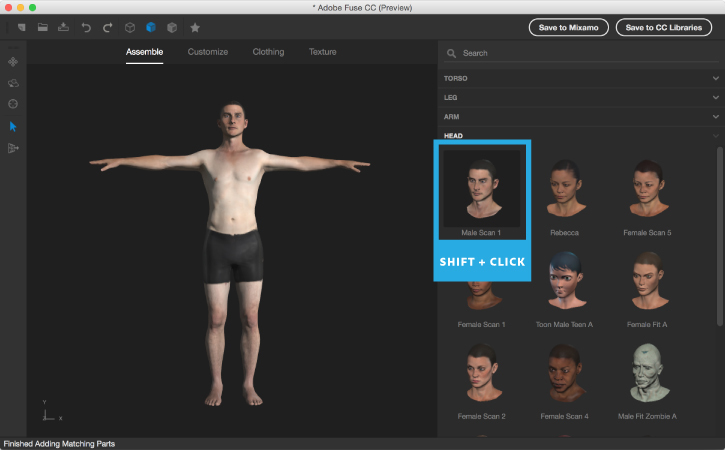
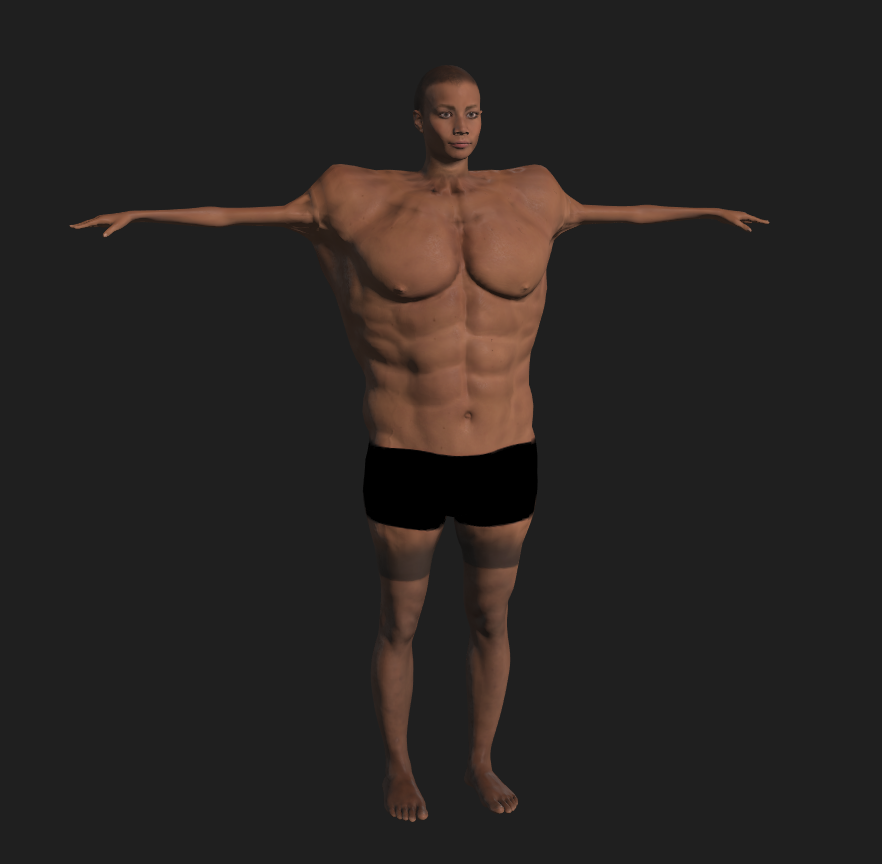
If this seems too complicated, the MakeHuman software seems to be a simpler and more suitable solution . It also allows you to adjust the mass of settings. For example, in order for the model to have a muscular body, you just need to move the “Muscle mass” slider upward. As a result, you can create a model that has appearance in the range from the character of Christian Bale in the movie "The Engineer" to Arnold Schwarzenegger, or even their extraordinary hybrid (see. Figure). The plus is that at the output it is possible to export a low-poly model, ready for use on mobile devices.
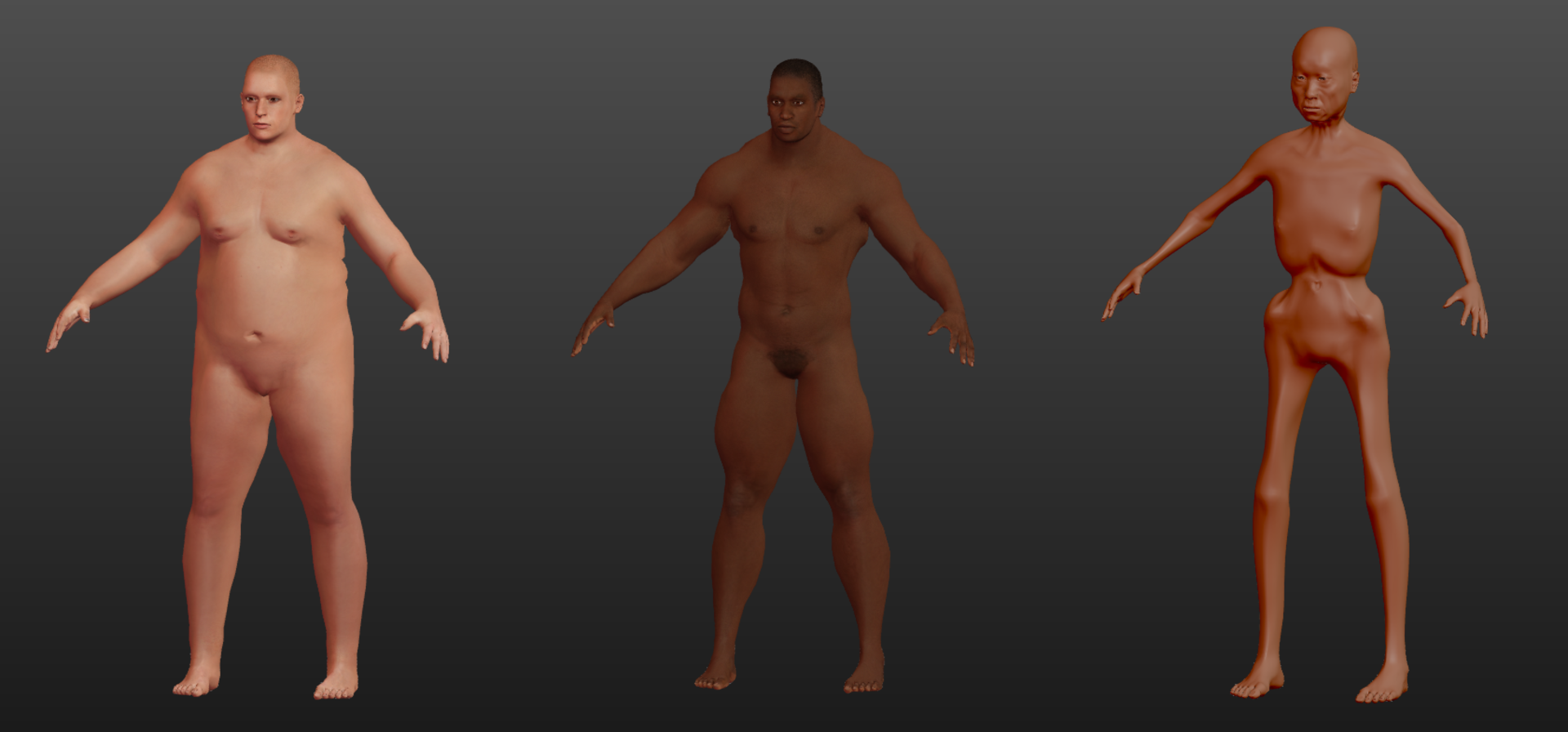
In Parkour Simulator 3D, some of the characters were modeled from scratch in Blender3D, and the other part was made in the MakeHuman package.

A very important component of parkour are animations. There are many examples of games with characters using manual movements and not very high quality. For example, this video makes the user feel like a noble puppeteer, but not a cool guy. Therefore, we clearly decided for ourselves that the plastic should be natural, created on the basis of the movements of a real person. Our studio, unfortunately, does not have the ability to use Motion Capture or similar technology, so we are forced to use the invention of Tim Burns-Lee, that is, the World Wide Web. I would like to highlight two main resources for finding suitable animations:
- Actually, the Unity Asset Store itself with its must have set for Mecanim.

- Mixamo.com website provides you with a huge number of ready-made animations that you can use for free in your game. The site has the opportunity to animate a finished model, taken from the resource library, or load your own and get the result in a few clicks, feeling like an almighty creator.
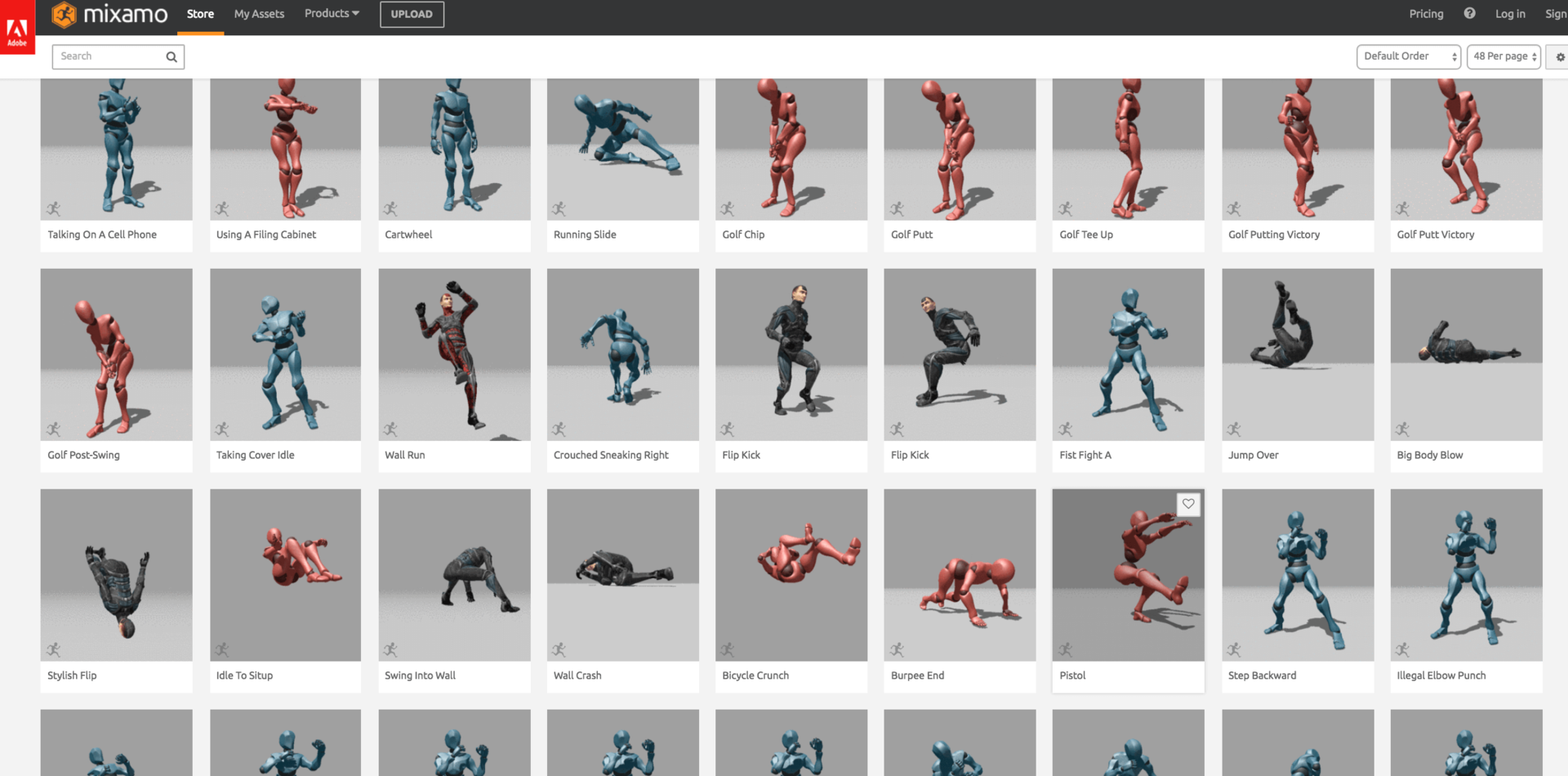
In Parkour Simulator 3D, we used animations from the Raw Mocap Data for Mecanim asset described above. In it we found jumping and tackle suitable for the hero, as well as running animations. Animations provided by Mixamo, we are currently using in updating the game.
So, the heroes are ready and at a low start, and now you need to lay the ground under their feet. Here again the choice arises - to give professionals the opportunity to earn their own bread or do everything yourself.
If everything is clear with the first, then in the implementation of the second option, the Asset Store will again be your best friend, where you can find many ready-made solutions that allow you to either get a ready-made location, or assemble it in parts.
Suitable Assets:
In Parkour Simulator 3D, we had the opportunity to simulate the main large elements of locations from scratch, and only some small elements of the environment were taken from the Asset Store.

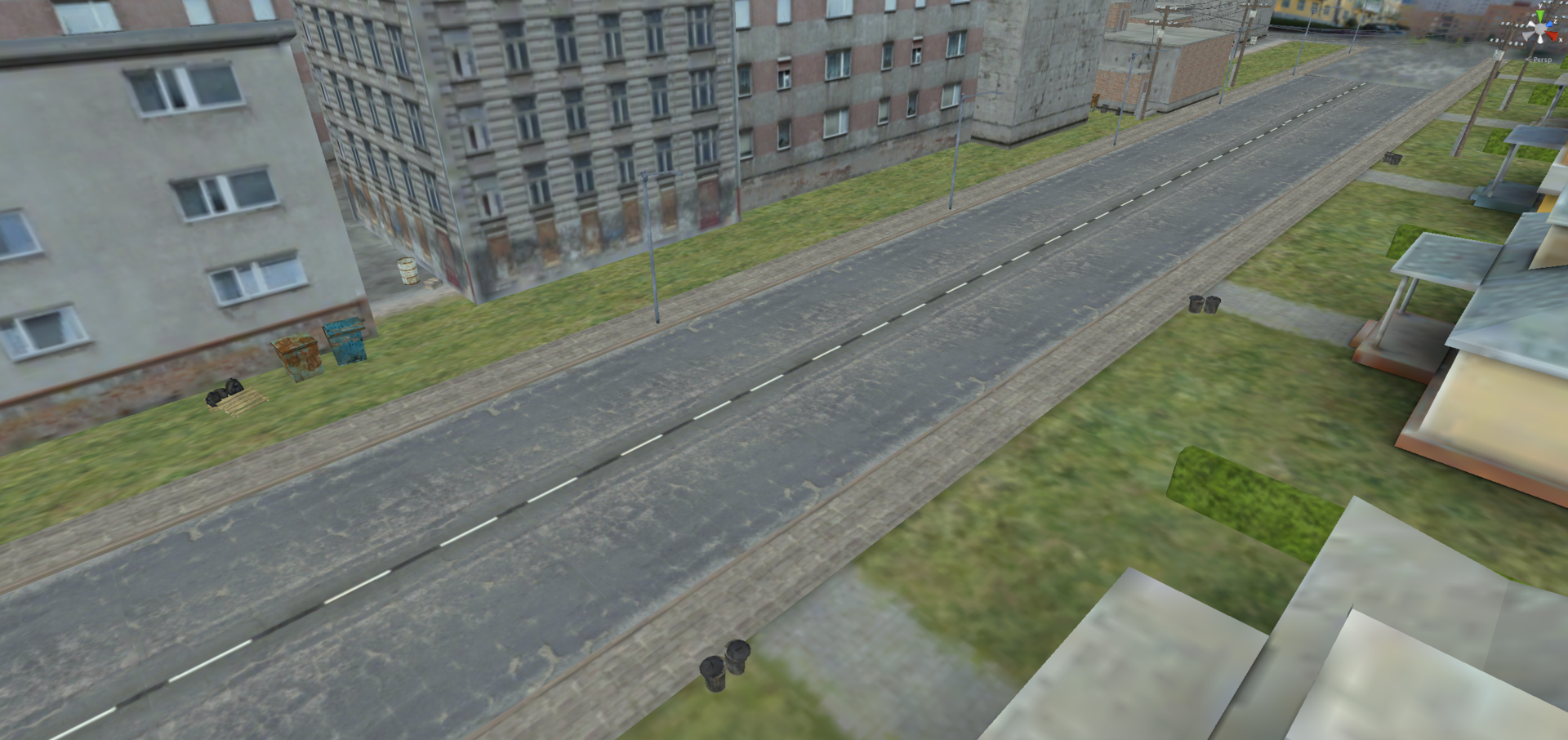
Having all the components, you can start development by applying all your C # programming knowledge in Unity3D. In this article we will not duplicate all the principles of optimization that were followed when developing Parkour Simulator 3D. You can read about this in, say, this article .
We hope that our experience has seemed interesting to you and will inspire you - what the hell is not joking - to create your own masterpiece in this area. "

“Imagine that one fine evening after watching the movie“ 13th District ”, you suddenly wanted to make your own game about crazy stunts, jumping over the abysses and the wonders of acrobatics, and even such that David Belle himself put 6 out of 5 stars on the market and suggested starring in a film based on motives, if any. Throwing a look at the Galaxy S7 smartphone lying on the table, you made a firm decision that the game will run on mobile platforms in order not only to undermine the Korean manufacturer with its coolness, but also to blow up the consciousness of players around the world. And here the main question arises: what should be the best mobile game about parkour and how to make it?
The theme of parkour at the moment remains relevant: this sports subculture is approaching the peak of popularity. The sequels of such hits as Mirrors's Edge and Vector are born. In this regard, when playing your game, users will involuntarily make comparisons. Of course, I want to take only the best from the subject, but at the same time submit it in my own original and unique style.
Today we will tell you how to make a game about parkour as an example of our current project Parkour Simulator 3D , implemented on the currently popular Unity3D development environment and its Mecanim system.
Tie
The bulk of the games about the heroes of "Yamakashi" at the start gives the player a character and shouts: "Run, Forest, run!". Where to? What for? Unclear. After two minutes of such a game, it becomes simply boring, especially if no progress is observed and you have to perform the same actions over and over again.
The player must have a goal. It is necessary to justify the character’s desire to run further, overcoming one obstacle after another. For example, in Vector, a player tries to escape and escape from pursuit at each level, at the end of which a safe shelter awaits him.
In Parkour Simulator 3D, we made a simple tie, somewhat reminiscent of the NFS: Most Wanted prologue, only instead of cool cars, characters use lower limbs to move around. The first animated scene makes it clear that you have to control a cool and popular tracer in your circle, who was challenged by an antagonist hero, a type of unpleasant appearance. After a short run, breaking into obvious leaders, the character falls into a trap and loses the competition, while losing his high status and respect of colleagues in the acrobatic workshop. Inspired by the tracer, the player is given the goal through the character - to take revenge on the scoundrel and regain its former glory. Thus, we cling to the user, taking him into the world of trials, the culmination of which will be the battle with the main boss.
At this stage, you as a developer need to determine how easier it is to convey this information to those who first launch the game. There are many options: use text, static or dynamic images, cutscenes (game scenes on the engine). We chose the option with animated images.
Game mechanics
You must decide how to build the gameplay in the game, how the player will interact with the character, environment, and the character development process.
In Parkour Simulator 3D, we took as a basis the mechanics of the runner, as the most suitable for a dynamic game. The world is generated procedurally, by alternating a certain set of blocks with obstacles for the player and for the opponent in a random way. Character development is achieved through the purchase of new tricks, acceleration and new costumes for coins earned in the race with opponents. With each new level, it becomes increasingly difficult to defeat enemies, respectively, to the stage of the battle with the boss, the player must come prepared, having with him full ammunition.
To implement something similar, we need to have in our arsenal character models, environments and Unity3D knowledge in order to assemble all this into one large interaction system.
Models
If you are good at 3D modeling skills, then there are no questions for you. Create a model of the future hero, using, for example, Blender3D, you will not be difficult. The only moment: if you want to speed up the process, third-party visualization tools, such as the Manuel Bastioni Laboratory plug-in, can help you generate a person’s model in one click according to the specified parameters. But be careful with the generation: instead of the coveted lean tracer, you might end up with a terrible ogre.

But what if you do not have such skills? In this situation, there are several options.
One of them is to use the services of a third-party modeler, who, if you wish, can create a model of Sebastien Foucan himself in a pose.
The second option will allow you to do everything yourself. There are special software packages that simplify the process of creating characters from scratch by changing certain parameters. Such is Adobe Fuse with a very thin and rich set of settings for the future hero. The only caveat is that at the output we get a high-poly model, the number of polygons which for use on mobile platforms will need to be reduced to the optimal number in the above Blender3D.


If this seems too complicated, the MakeHuman software seems to be a simpler and more suitable solution . It also allows you to adjust the mass of settings. For example, in order for the model to have a muscular body, you just need to move the “Muscle mass” slider upward. As a result, you can create a model that has appearance in the range from the character of Christian Bale in the movie "The Engineer" to Arnold Schwarzenegger, or even their extraordinary hybrid (see. Figure). The plus is that at the output it is possible to export a low-poly model, ready for use on mobile devices.

In Parkour Simulator 3D, some of the characters were modeled from scratch in Blender3D, and the other part was made in the MakeHuman package.

Animations
A very important component of parkour are animations. There are many examples of games with characters using manual movements and not very high quality. For example, this video makes the user feel like a noble puppeteer, but not a cool guy. Therefore, we clearly decided for ourselves that the plastic should be natural, created on the basis of the movements of a real person. Our studio, unfortunately, does not have the ability to use Motion Capture or similar technology, so we are forced to use the invention of Tim Burns-Lee, that is, the World Wide Web. I would like to highlight two main resources for finding suitable animations:
- Actually, the Unity Asset Store itself with its must have set for Mecanim.

- Mixamo.com website provides you with a huge number of ready-made animations that you can use for free in your game. The site has the opportunity to animate a finished model, taken from the resource library, or load your own and get the result in a few clicks, feeling like an almighty creator.

In Parkour Simulator 3D, we used animations from the Raw Mocap Data for Mecanim asset described above. In it we found jumping and tackle suitable for the hero, as well as running animations. Animations provided by Mixamo, we are currently using in updating the game.
Environment
So, the heroes are ready and at a low start, and now you need to lay the ground under their feet. Here again the choice arises - to give professionals the opportunity to earn their own bread or do everything yourself.
If everything is clear with the first, then in the implementation of the second option, the Asset Store will again be your best friend, where you can find many ready-made solutions that allow you to either get a ready-made location, or assemble it in parts.
Suitable Assets:
- Low Poly Street Pack ;
- Stylized and Modular City ;
- Industrial Object Pack ;
- Sample Racer Env Pack ;
- The Wasteland Lite ;
- Free Shipping Conteiners ;
- Building Kit 1 ;
- Free Steel Frame Pack .
In Parkour Simulator 3D, we had the opportunity to simulate the main large elements of locations from scratch, and only some small elements of the environment were taken from the Asset Store.


Development
Having all the components, you can start development by applying all your C # programming knowledge in Unity3D. In this article we will not duplicate all the principles of optimization that were followed when developing Parkour Simulator 3D. You can read about this in, say, this article .
We hope that our experience has seemed interesting to you and will inspire you - what the hell is not joking - to create your own masterpiece in this area. "
